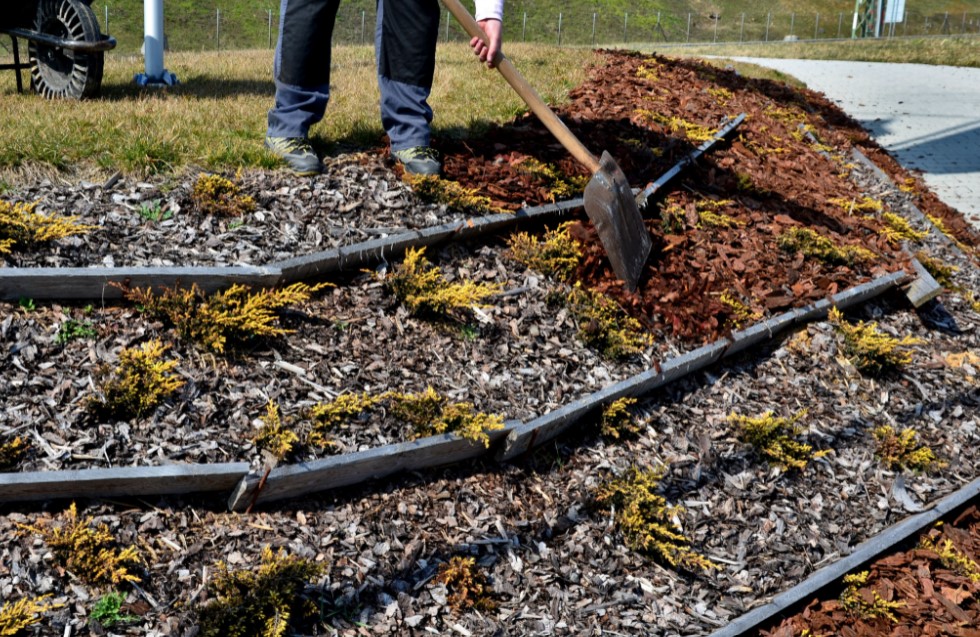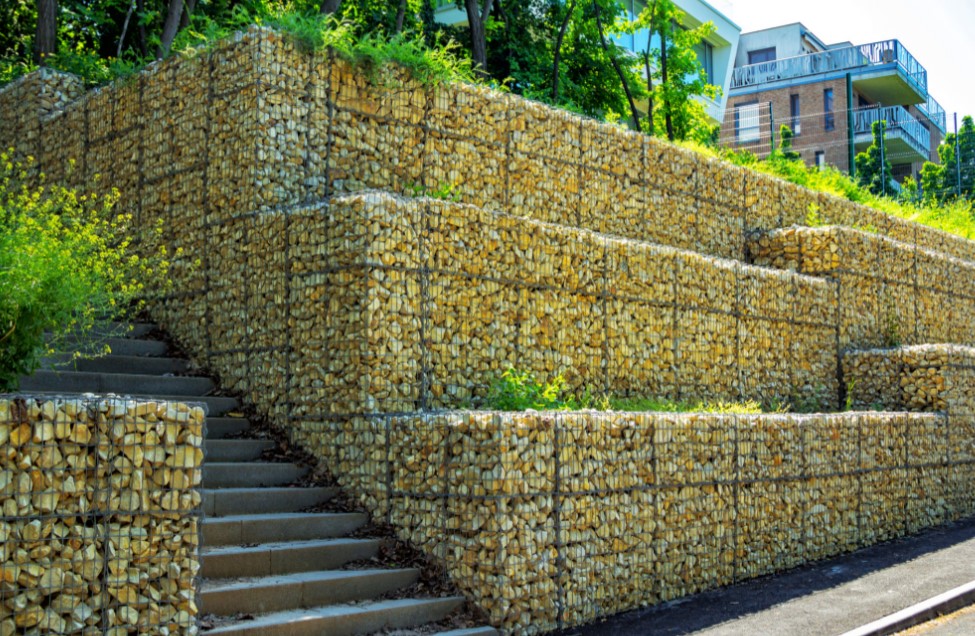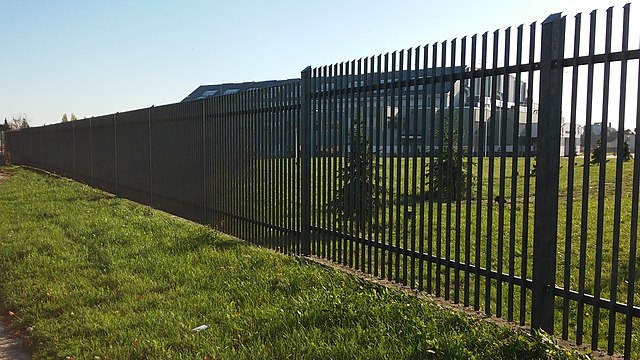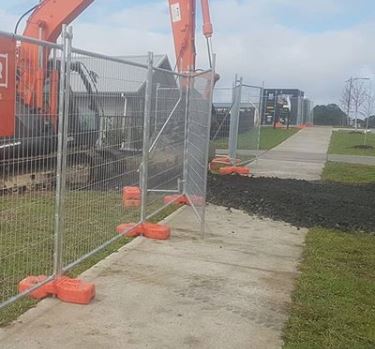Erosion control on sloped landscapes is an important part of landscaping on commercial and residential construction sites in New Jersey. Erosion can cause significant damage to the sandy, Jersey Shore landscape, including soil loss and destruction of plants, and other vegetation.
In addition, erosion can lead to water pollution and sedimentation in nearby bodies of water like the rivers and streams in Monmouth and Ocean county and even the Barnegat bay. Fortunately, there are several methods that can be used to reduce or prevent erosion on sloped landscapes.

Erosion And Its Effects On Sloped Landscapes
Erosion is the gradual wearing away of soil and rock by wind and water. On sloped landscapes, erosion can have significant effects as gravity accelerates the removal of materials. As rain and runoff wash soil down a hillside, the slope becomes less stable, increasing the risk of mudslides and landslides. Gullies form as the soil is removed, altering the contours of the terrain.
Over time, entire hillsides can be worn away, reducing elevation and changing the shape of mountains and valleys. Erosion control techniques like retaining walls, drainage swales, and hydroseeding plantings can help mitigate these impacts, but erosion remains an inevitable force of nature that continuously reshapes our sloped landscapes.
Why Does Erosion Occur On Loose Soil
Erosion is a natural process that occurs when loose soil is carried away by wind, water, or other forces. Loose soil particles with poor structure and few soil aggregates are more vulnerable to erosion than compacted ones, as they can easily be moved and washed away by external factors. This is why erosion is more common in areas with loose soil, such as riverbanks or hillsides.
Soil erosion can have severe consequences, including loss of arable land, damage to infrastructure, and environmental degradation. For this reason, it is important to understand how to use erosion control products to prevent it. By stabilizing soil with vegetation or other methods, we can reduce erosion and preserve the integrity of our natural and built environments.
Factors to Consider Before Implementing Erosion Control on Sloped Landscapes
Soil Type and Characteristics
The soil type and its characteristics are essential factors to consider before implementing erosion control for slopes. Different types of soil have distinct properties such as texture, water retention capacity, and nutrient content, which impact their stability.
For instance, the sandy soils of Ocean County are more prone to erosion and require more stabilization measures than fine-grained clay soils with more water retention capacity. The other extreme is also problematic because compacted soils have a lower infiltration rate, which leads to flooding and surface runoff. Loose soils that are low in organic matter and vegetation have lower water retention capacity and are more susceptible to erosion because there is less absorbent material, fewer microbes and plant roots to help glue the soil together and hold it in place.

Topography and Slope Gradient
The overall topography and slope gradient will significantly impact the stability of a landscape when preventing soil erosion. The steepness of the slope influences the intensity of water flow and the sediment’s movement, making it more difficult to establish vegetation cover and retention measures.
A steep slope may require more complex measures such as terracing, gabion walls, retaining walls, and reinforced soil slopes that can withstand the high hydrostatic forces. Conversely, gentle slopes may be stabilized by vegetation cover and mulching techniques with minimal intervention.
Hydrology and Drainage Patterns
Hydrology and drainage patterns play a crucial part in the erosion control plan, and the site’s location and climatic conditions significantly influence these factors. Heavy rainfall, flash floods, and slope instability can lead to severe soil erosion, making it essential to consider drainage patterns before deciding on erosion control measures.
For instance, implementing effective drainage measures such as bioswales, infiltration trenches, or catchment basins can help direct surface water runoff from the sloped landscape and prevent further soil erosion.
Vegetation Cover and Type
The choice of vegetation cover and type is extremely crucial in controlling slope erosion. Vegetation serves as a natural barrier that helps slow down the flow of water and retain the soil, reducing the risk of erosion.
Before selecting the vegetation cover and type, consider the slope gradient, soil type, and climatic conditions, as some plants may require more water or nutrients than others. Groundcovers, shrubs, and trees with a deep root system are excellent erosion control measures that improve soil structure, reduce runoffs, and enhance overall soil health.
Importance Of Erosion Control Measures
Erosion control measures are critical to mitigating soil loss and protecting land stability. Without proper precautions, heavy rain and flooding can rapidly wash away fertile land, damaging property and infrastructure. Simple steps like installing silt fences, straw bales, and re-vegetating bare soil are cost-effective ways to control erosion.
Maintaining ground cover with hydroseeding grass, erosion control mulch, or erosion control blankets is key, as exposed soil is vulnerable to the elements. By taking proactive erosion control actions, we can preserve the integrity of the land for future generations while safeguarding communities from the harmful effects of erosion.
Erosion Control Methods for Sloped Landscapes
Use of live stakes and brush layering
Live stakes are pretty much that. There are live twigs or branches taken from cuttings that are carefully drilled or pounded into the ground to help expand a plant’s root structure while holding dirt in place.
Brush layering works by piling the brush, preferably with hardwood branches, and interlacing them within the soil to help reinforce the area. Both techniques encourage vegetation growth to help prevent landscape erosion.
Using Coir Logs And Wattles To Stop Erosion
Coir logs, or erosion control socks, and wattles are made of coconut fiber and are wrapped with mesh or natural fibers, respectively. They are very effective in controlling soil erosion because they are flexible and can adapt to any slope and terrain. In other words, they are perfect for steep slopes, wetlands, or river banks. They work by absorbing water, which means they prevent soil erosion and at the same time promote vegetation.
Installation of geotextiles and erosion control blankets
Geotextiles are fabrics that are buried in the soil and used for reinforcement. They act as a barrier, separating different types of soil from each other. An erosion control blanket, on the other hand, provides temporary protection from erosion but also increases the rate of plant germination and growth. They are easy to install and come in many different materials and sizes, depending on the area you want to cover.
Construction of retaining walls and terraces
Retaining walls and terraces are structures that can be used to control erosion on a sloping landscape. A retaining wall helps to hold back soil and water while redirecting water runoff in the desired direction. Terraces work similarly to retaining walls, but they are designed for areas with a gentle slope.
Use of soil stabilizers and erosion control mulch
Soil stabilizers, also called soil binders, work by strengthening the bonds between soil particles to improve soil stability. This process is usually done by adding chemicals to the soil, and these chemicals react to help hold soil in place. Erosion control mulch, on the other hand, is biodegradable and ideal for controlling hillside erosion. It’s a specialized type of mulch that is made up of natural fibers that help reduce erosion by increasing the absorption rate of water.
Final Thoughts About Erosion Control On Slopes
Controlling erosion on a garden slope is crucial for preserving the stability and integrity of the land. There are numerous approaches to prevent erosion, ranging from bioengineering techniques like live stakes and brush layering to mechanical stabilization methods such as geotextiles or terraces.
Strategic rock placement and chemical stabilization measures, including soil stabilizers and erosion control mulch, can also effectively control soil loss on steeper slopes. By familiarizing yourself with various erosion prevention methods, you’ll be better prepared to select the right ones for your specific landscape requirements. Taking proactive measures now, especially on planted slopes, will ensure the safety of our valuable land resources for generations to come.



